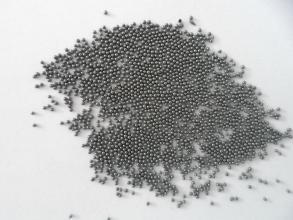Tips of Blasting Steel Pipes
Blasting is a kind of surface treatment for steel pipes which is driven by high-power blasting machine with high-speed blades and metal abrasives and grit. This method can not only eradicate the rust, but the pipes can have uniform roughness under sever impact and friction force. Therefore, the blasting is an ideal measure for anti-corrosion of steel pipes. There are some details that should be noticed when blasting the steel pipes.
1. Selection of abrasives
The selection of abrasives should according to the hardness, roughness and coated types of steel pipes. For single, double and three layers polyethylene coating, combine steel grit and steel shot can achieve the ideal effect. The steel shot can strengthen the surface of steel and the grit can etch the surface. Usually, the hardness of steel shot is 40 to 59 HRC, and the steel grit is 50 to 60 HRC, even use the combined abrasives on C and D grade of rusted surface of steel pipes, it’s still effective.
2. Particle size and proportion of abrasives
In order to have a better cleanliness and roughness, it’s important to have appropriate size and proportion of abrasives. If the abrasive particles are too large it will easily hurt the corrosion coating of steel pipes, and influence the performance of coating. If the abrasive particles are too small, it will impair impact strength of steel pipes. For serious internal rust, it’s not enough to only rely on the large abrasive particles but also need small particles to eradicate the rust and achieve an ideal effect. The appropriate proportion can not only release the abrasion on pipes and blades, but also can greatly improve the utilization of abrasives. In general, the diameter of steel shot is 0.8 to 1.3 mm, steel grit is 0.4 to 1.0 mm, and abrasive with 0.5 to 1.0 mm diameter should be the major component.
It should be noticed that, practically, it’s difficult to have the ideal proportion of steel grit and steel shot, the reason is that the steel grit is more brittle than steel shot. Therefore, manufactures should add new abrasives during blasting, and the proportion of steel grit should be predominant.
3. Cleaning and preheat
Before blasting, clean the accumulated dust and grease preheat steel pipes to 60 ℃ or so, keep the pipe surface in a dry state. The clean pipe surface without dust and grease can reinforce the effect of blasting. The dryness is conducive to the separation between shot, grit and rusted scale, and the surface will be cleaner after blasting.
1. Selection of abrasives
The selection of abrasives should according to the hardness, roughness and coated types of steel pipes. For single, double and three layers polyethylene coating, combine steel grit and steel shot can achieve the ideal effect. The steel shot can strengthen the surface of steel and the grit can etch the surface. Usually, the hardness of steel shot is 40 to 59 HRC, and the steel grit is 50 to 60 HRC, even use the combined abrasives on C and D grade of rusted surface of steel pipes, it’s still effective.
2. Particle size and proportion of abrasives
In order to have a better cleanliness and roughness, it’s important to have appropriate size and proportion of abrasives. If the abrasive particles are too large it will easily hurt the corrosion coating of steel pipes, and influence the performance of coating. If the abrasive particles are too small, it will impair impact strength of steel pipes. For serious internal rust, it’s not enough to only rely on the large abrasive particles but also need small particles to eradicate the rust and achieve an ideal effect. The appropriate proportion can not only release the abrasion on pipes and blades, but also can greatly improve the utilization of abrasives. In general, the diameter of steel shot is 0.8 to 1.3 mm, steel grit is 0.4 to 1.0 mm, and abrasive with 0.5 to 1.0 mm diameter should be the major component.
It should be noticed that, practically, it’s difficult to have the ideal proportion of steel grit and steel shot, the reason is that the steel grit is more brittle than steel shot. Therefore, manufactures should add new abrasives during blasting, and the proportion of steel grit should be predominant.
3. Cleaning and preheat
Before blasting, clean the accumulated dust and grease preheat steel pipes to 60 ℃ or so, keep the pipe surface in a dry state. The clean pipe surface without dust and grease can reinforce the effect of blasting. The dryness is conducive to the separation between shot, grit and rusted scale, and the surface will be cleaner after blasting.

